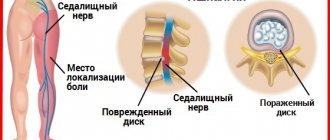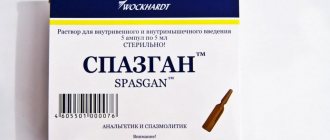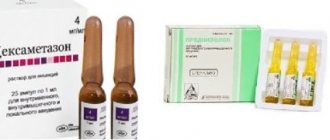Pharmacology
Pharmacological action: anti-inflammatory, analgesic, antipyretic.
Indiscriminately inhibits the activity of cyclooxygenase (COX-1 and COX-2) and reduces the synthesis of PG. Reduces uric acid levels in the blood.
When taken orally, it is quickly absorbed from the gastrointestinal tract. Cmax is reached in 1–2 hours. Bioavailability is 85–90%, decreases with long-term use. Plasma protein binding is more than 95%. It is biotransformed in the liver to form two main metabolites. It is excreted in significant quantities in breast milk. T1/2 - 18–21 hours. Excreted in urine 70% (5% unchanged), through the gastrointestinal tract - 30% (in the form of metabolites).
Pharmacological qualities
Phenylbutazone, according to the instructions, is used to eliminate various inflammatory processes. The medication belongs to the butadione group of non-steroids. The action of the main medicinal component is aimed at blocking a number of enzymes.
The goal is to stop or at least partially reduce the rate of prostaglandin production. It is these substances that are responsible for the speed of development of inflammatory reactions, as well as their intensity and severity.
Due to a drop in the level of prostaglandins, body temperature returns to normal (especially in those areas where inflammation develops), swelling decreases, and the overall level of discomfort decreases.
Acetylsalicylic acid, as a classic NSAID, has a similar effect. But Phenylbutazone has much more pronounced pharmacological properties.
A thorough study of the Phenylbutazone formula, as well as its key physicochemical and pharmacological properties, revealed one interesting fact. The drug allows you to remove some amount of uric acid from the body.
Application
For systemic use: inflammatory and degenerative diseases of the musculoskeletal system - rheumatoid arthritis, gouty, psoriatic arthritis, ankylosing spondylitis (Bechterew's disease), osteoarthritis, arthritis with systemic lupus erythematosus (as part of complex therapy). Pain syndrome: bursitis, tendovaginitis, arthralgia, myalgia, neuralgia, migraine, toothache and headache, algodismenorrhea; pain from injuries, burns. Feverish syndrome (“colds” and infectious diseases).
For local use: articular syndrome with exacerbation of gout, rheumatoid arthritis, osteoarthritis, ankylosing spondylitis. Pain syndrome (weak and moderate intensity) - arthralgia, myalgia, neuralgia, phantom pain; dermatitis caused by various chemical and mechanical influences, burns (I and II degrees of a small area, including solar), inflammation of the skin at the sites of IM and IV injections, insect bites, superficial thrombophlebitis, inflammation of hemorrhoids, traumatic injuries of soft tissues, inflammatory infiltrates, hematoma, muscle and tendon sprains, bursitis, tenosynovitis.
Nosological classification (ICD-10)
G43 Migraine G54.6 Phantom limb syndrome with pain I80 Phlebitis and thrombophlebitis I84 Hemorrhoids K08.8.0* Dental pain L30.9 Dermatitis, unspecified L40.5 Arthropathic psoriasis (M07.0-M07.3*, M09.0*) L55 Sunburn L98.6 Other infiltrative diseases of the skin and subcutaneous tissue M06.9 Rheumatoid arthritis, unspecified M10 Gout M13.9 Arthritis, unspecified M14.8 Arthropathy in other specified diseases classified elsewhere M19.9 Arthrosis, unspecified M25.5 Pain in the joint M45 Ankylosing spondylitis M65 Synovitis and tenosynovitis M71 Other bursopathies M79.1 Myalgia M79.2 Neuralgia and neuritis, unspecified N94.6 Dysmenorrhea, unspecified R50 Fever of unknown origin R51 Headache R52.2 Other persistent pain R68.8.0* Inflammatory syndrome T14 Trauma of unspecified localization T14.0 Superficial trauma to an unspecified area of the body T14.3 Dislocation, sprain and damage to the capsular-ligamentous apparatus of a joint of an unspecified area of the body T30 Thermal and chemical burns of an unspecified localization W57 Bite or stinging by non-venomous insects and other non-venomous arthropods
Contraindications
Hypersensitivity. For oral administration: “aspirin” triad (a combination of bronchial asthma, recurrent polyposis of the nose and paranasal sinuses and intolerance to acetylsalicylic acid and pyrazolone-type drugs), erosive and ulcerative lesions of the gastrointestinal tract in the acute stage (peptic ulcer of the stomach and duodenum, ulcerative colitis, peptic ulcer ), bone marrow depression, decompensated chronic heart failure or pulmonary heart failure, severe liver and/or kidney failure.
For local use: trophic ulcers, violation of the integrity of the skin, eczema.
Reviews
Maryana, 45 years old, Kazan “I have been suffering from bursitis for a very long time. Non-steroids usually caused stomach pain and severe nausea. The doctor prescribed Phenylbutazone as a replacement drug. The stomach did not bother me while taking this drug, although nausea appeared from time to time. They prescribed a minimal dosage, but it helped solve the problem. Overall satisfied. I have completely given up other non-steroidal drugs for now.”
Alexander, 61 years old, Krasnoyarsk “I heard about the drug Phenylbutazone as a “horse medicine.” At the same time, they did not respond very well to him. I don’t know how it is in animals, but people can clearly benefit from this remedy. I suffer from neuralgia from time to time. This is the only drug that helps me out.”
Side effects
When taken orally
From the gastrointestinal tract: dyspepsia, NSAID gastropathy, abdominal pain, nausea, vomiting, heartburn, diarrhea/constipation; with long-term use in large doses - ulceration of the gastrointestinal mucosa, aphthous stomatitis, glossitis, erosive esophagitis, bleeding from the gastrointestinal tract, incl. gingival, hemorrhoidal, liver dysfunction.
From the cardiovascular system and blood (hematopoiesis, hemostasis): increased blood pressure, tachycardia, agranulocytosis, leukopenia, anemia, thrombocytopenia.
From the nervous system and sensory organs: headache, dizziness, drowsiness, depression, agitation, hearing loss, tinnitus.
Allergic reactions: skin rash, itching, urticaria, bronchospasm, edema syndrome, angioedema syndrome.
Other: increased sweating, uterine bleeding.
When applied topically: allergic reactions (including skin rash).
PHENYLBUTAZONE (Butadione)
Surpasses aspirin in terms of anti-inflammatory effect. Enhances the removal of uric acid from the body.
Pharmacokinetics
The maximum concentration in the blood develops 2 hours after oral administration and only 6-8 hours after intramuscular administration (since phenylbutazone binds to the tissues at the injection site). The half-life is approximately 70 hours. One of the metabolites of phenylbutazone is oxyphenbutazone
– is available as a separate drug and is equivalent to phenylbutazone in all respects (including toxicity).
Interactions
Phenylbutazone is one of the most powerful “displacers” of other drugs in connection with plasma albumin, which leads to an increase in the concentration of the free (active) fraction of these drugs in the blood. In addition, it may inhibit the metabolism of certain drugs in the liver. Therefore, when combined with phenylbutazone, it is possible to enhance the effect of indirect anticoagulants, oral antidiabetic drugs, sulfonamides and other drugs.
By worsening renal blood flow, phenylbutazone weakens the effect of diuretics and antihypertensive drugs.
Adverse reactions
The widespread use of phenylbutazone is limited by its frequent and serious adverse reactions, which occur in 45% of patients. The most dangerous is the depressive effect of the drug on the bone marrow, which results in hematotoxic reactions
– aplastic anemia and agranulocytosis, often causing death. The risk of aplastic anemia is higher in women, in people over 40 years of age, and with long-term use. However, even with short-term use by young people, fatal aplastic anemia can develop. Leukopenia, thrombocytopenia, pancytopenia and hemolytic anemia are also noted.
In addition, there are undesirable reactions from the gastrointestinal tract (erosive and ulcerative lesions, bleeding, diarrhea), fluid retention in the body with the appearance of edema, skin rashes, ulcerative stomatitis, enlarged salivary glands, disorders of the central nervous system (lethargy, agitation, tremor), hematuria, proteinuria, liver damage.
Phenylbutazone has cardiotoxicity (in patients with heart failure, its exacerbation is possible) and can cause acute pulmonary syndrome, manifested by shortness of breath and fever. A number of patients experience hypersensitivity reactions in the form of bronchospasm, generalized lymphadenopathy, skin rashes, Lyell's and Stevens-Johnson syndromes. Phenylbutazone and especially its metabolite oxyphenbutazone can lead to exacerbation of porphyria.
Indications
Phenylbutazone should be used as a backup NSAID when other drugs are ineffective, in a short course.
The greatest effect is observed in cases of ankylosing spondylitis and gout.
Warnings
Do not use phenylbutazone and combination drugs containing it ( reopyrit, pyrabutol
) as analgesics or antipyretics in widespread clinical practice.
Considering the possibility of developing life-threatening hematological complications, it is necessary to warn patients about their early manifestations and strictly follow the rules for prescribing pyrazolones and pyrazolidines.
Rules for the use of phenylbutazone and other pyrazolidine and pyrazolone derivatives
- Prescribe only after a thorough history, clinical and laboratory examination with determination of red blood cells, leukocytes and platelets. These studies should be repeated at the slightest suspicion of hematotoxicity.
- Patients should be warned to immediately stop treatment and urgently consult a doctor if the following symptoms appear: A one-week course is sufficient to assess the effectiveness. If there is no effect, the drug should be discontinued. In patients over 60 years of age, phenylbutazone should not be used for more than 1 week.
- fever, chills, sore throat, stomatitis (symptoms of agranulocytosis);
- dyspepsia, epigastric pain, unusual bleeding and bruising, tarry stools (symptoms of anemia);
- skin rash, itching;
- significant weight gain, edema.
Phenylbutazone is contraindicated in patients with hematopoietic disorders, erosive and ulcerative lesions of the gastrointestinal tract (including a history of them), cardiovascular diseases, thyroid pathology, impaired liver and kidney function, and allergies to aspirin and other NSAIDs. It can worsen the condition of patients with systemic lupus erythematosus.
Dosage
Adults:
initial dose – 450-600 mg/day in 3-4 doses.
After achieving a therapeutic effect, maintenance doses are used - 150-300 mg/day in 1-2 doses.
Not used in children
Release forms:
– tablets 150 mg; – ointment, 5%.
Source: https://psora.net
Interaction
Phenylbutazone enhances the effect of indirect anticoagulants, antiplatelet agents, and fibrinolytics. May delay the excretion of various drugs (including morphine, PAS, penicillin, oral anticoagulants, antidiabetic agents) by the kidneys, promote their accumulation in the body and may cause side effects. Increases the concentration of Li+ and methotrexate in the blood. Phenylbutazone reduces the effectiveness of uricosuric, antihypertensive drugs and diuretics. Antacids and cholestyramine reduce absorption. Myelotoxic drugs increase the manifestations of hematotoxicity.
Release form and main effects
The drug is prescribed to solve a whole range of therapeutic problems in various fields.
Phenylbutazone, according to the instructions for use, has the following effects: pain relief, elimination of acute inflammatory reactions, reduction of fever in points where there is particular activity of the pathological process.
Three different forms of this drug are available for patients on the pharmacological market:
- Tablets (0.15 g, 0.05 g, 0.03 g);
- Ointment 5% (20 g);
- Injection.
Precautionary measures
During treatment, monitoring of the peripheral blood picture and the functional state of the liver and kidneys is necessary. If it is necessary to determine 17-ketosteroids, the drug should be discontinued 48 hours before the study.
During treatment, you should refrain from engaging in potentially hazardous activities that require increased attention and speed of mental and motor reactions.
The ointment is not used to treat deep vein thrombophlebitis. In the case of treatment of superficial thrombophlebitis, it should be taken into account that the drug does not replace anticoagulant therapy. When applying the drug to injured skin for a long time, it is recommended to carry out a control study of the peripheral blood picture every 2–4 weeks.
Overdose
The main symptoms indicating an overdose of Phenylbutazone drugs:
- Blueness of lips and mucous membranes;
- Cyanosis of fingers;
- A sudden attack of severe dizziness, up to complete loss of orientation in space;
- A jump in blood pressure (systolic and diastolic readings can be either abnormally low or dangerously high);
- Clouding of consciousness;
- Increasing headache.
Nonsteroidal poisoning is especially severe in the youngest patients. Children may experience attacks of myoclinic convulsions, develop severe vomiting, and develop signs of hemorrhage. Renal and liver dysfunction are often noted as transient conditions. Sometimes in a particularly acute and intense form.
If such situations occur, you should immediately call an ambulance. The patient’s stomach is immediately washed, and at the same time they are given activated carbon or any other sorbent to drink.
Subsequently, the patient is given assistance taking into account exactly what symptoms are bothering him.
Hemodialysis is not practiced due to its ineffectiveness in this case. Subsequently, symptomatic treatment and restoration of all organs and systems are carried out.





